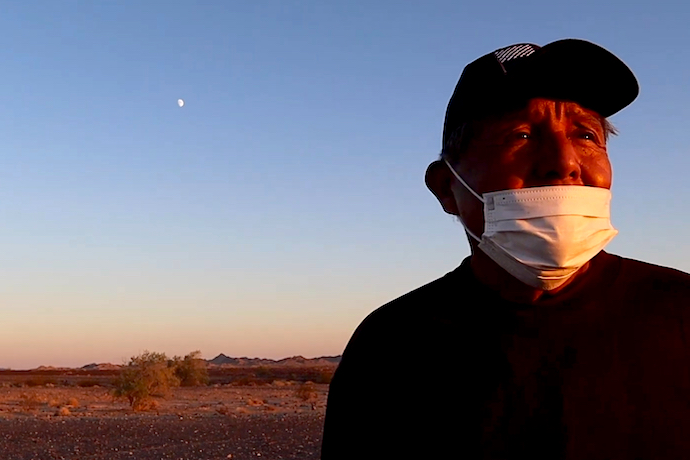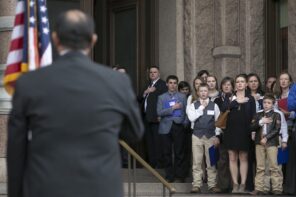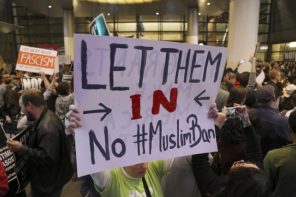As the Ninth Circuit Court of Appeals gets ready to hand down a decision in Apache Stronghold v. United States, religious leaders—Sikh, Jewish, Muslim, Catholic, Mennonite—who have filed amicus briefs urging the court to protect not only Apache sacred sites but religious freedom itself—are holding their collective breath, waiting for the court’s decision. But should they be optimistic?
Chi’chil Bildagoteel, known in English as Oak Flat, is the place where Ga’an (guardians or messengers between Apache peoples and the Creator, Usen) reside. It’s a 6.7 square mile stretch of land within what is currently managed by the U.S. federal government as Tonto National Forest, east of Phoenix, Arizona. Since 2014, a proposed copper mine has threatened to permanently alter the area through an underground mining technique that would cause the earth to sink—up to 1,115 feet deep and almost 2 miles across.
Apache Stronghold, a grassroots organization devoted to defending sacred sites, has challenged the proposed mining plan in court, arguing that destroying their sacred sites would infringe on their free exercise of religion, a right promised to them by the First Amendment to the U.S. Constitution, the American Indian Religious Freedom Act (1978), and the Religious Freedom Restoration Act (1993).
This case has precedent working against them, however. In Lyng v. Northwest Indian Cemetery Protective Association, the U.S. Supreme Court declared constitutional a plan to build a road and log trees in the High Country in Northern California, an area sacred to the Yurok, Karuk, and Tolowa peoples.
Forty years after the Lyng case was tried in court, the Apache are arguing that, even though the cases sound very similar, and even though the court failed to protect the High Country from development, it should nonetheless protect Oak Flat. (Despite the Supreme Court ruling the High Country has been protected by Congress as wilderness.)
There are two main differences between the cases. The Yurok, Karuk, and Tolowa relied on the free exercise clause of the First Amendment and on the American Indian Religious Freedom Act, a law that requires only consultation with Indigenous peoples before destroying their sacred sites, not consent. But in 1993 the Religious Freedom Restoration Act was enacted to bypass the Lyng precedent and offer better protection to religious minorities, a law the Apache rely on in their claim against the destruction of Oak Flat.
More substantially, the Apache argue that, because Oak Flat would be utterly destroyed by the mining, no religious exercise at this sacred site would be possible at all if it is mined.
Initially, a three-judge panel of the Ninth Circuit Court of Appeals rejected their claim, justifying the decision by saying that, since the Apache only recently revived their ceremonial use of Oak Flat, destroying it does not pose a substantial burden on their free exercise of religion. While scholars argue that this justification is factually wrong, reading this case through the theoretical lens of settler colonialism adds a layer of cruel irony to the court’s justification. If Apache ceremonial life in the area had until recently been suppressed, preventing them from making use of this sacred site, we should look to the settler state as culprit.
To put it more succinctly: The state (in the form of the court) ruled that the Apache have no right to preserve this sacred site because they neglected to maintain their tradition—a situation for which the state itself was responsible.
The mining is conditioned on a successful environmental review, and so at the time of this writing there’s still a chance that Oak Flat will be protected for environmental reasons—not unlike the High Country that’s been protected as wilderness. However, unless Apache Stronghold wins this round at the Ninth Circuit Court of Appeals or takes the case to the Supreme Court and wins there, Oak Flat will not be protected as a sacred place. The religious leaders who submitted amicus briefs to the court believe that it matters, not only whether, but how, Oak Flat is protected. If it’s not protected as sacred, their minoritized religions are in danger, too.
But cases involving Native American sacred sites are different from other religious freedom cases because they inevitably present us with two competing rights—one party’s religious freedom is in tension with another party’s property rights. For example, a Native nation argues that a specific place is sacred to it, but this place is officially owned by someone else (usually the U.S. government). If the Indigenous nation asks to be able to use the place for religious purposes (to hold a ceremony, for example), one might think that what it’s really asking is to suspend the government’s property rights in order to protect Native religion.
But if this is how the issue is framed—as a competition between property rights and religious rights—we can expect the Native claimants to lose, because in liberal political discourse, property is the paradigmatic right and land is the paradigmatic property.
One might say that because of religion’s special status in the U.S. Constitution’s First Amendment, religion actually transcends property relations; that it’s the one thing that’s excluded from property relations. However, in cases like Lyng or Oak Flat, religion does not challenge the logic of property; it’s understood as merely one right among many. Framing sacred sites cases in this way sets two (ostensibly) mutually exclusive conceptions of land against each other: either land is sacred or it’s property. In this case, it would be public property.
But what does “public property” mean? And who is the “public” whose opinion about the fate of this land should be considered? This question is complicated by the fact that the High Country is Karuk aboriginal territory, though one certainly doesn’t learn that from reading the Supreme Court decision in Lyng. In the Oak Flat case, the court does acknowledge that the area is Apache aboriginal territory, yet it’s not the Apache peoples who get to decide the land’s fate.
What would happen if, instead of thinking about Oak Flat as a place sacred to the Apache peoples we, and the court, were to think about it as their homeland? What if what they ask the court to do is to protect their sovereignty; that is, their right to decide the fate of the place rather than their right to worship there?
There doesn’t seem to be a legal framework that would allow the Apache to ask the court to protect Oak Flat as anything but a place sacred to them. Therefore, and given the history of Native American sacred sites cases, we may have to conclude that settler law is incapable of protecting Indigenous land from the settler state. The problem, as it turns out, is not religious freedom, but settler colonialism.




